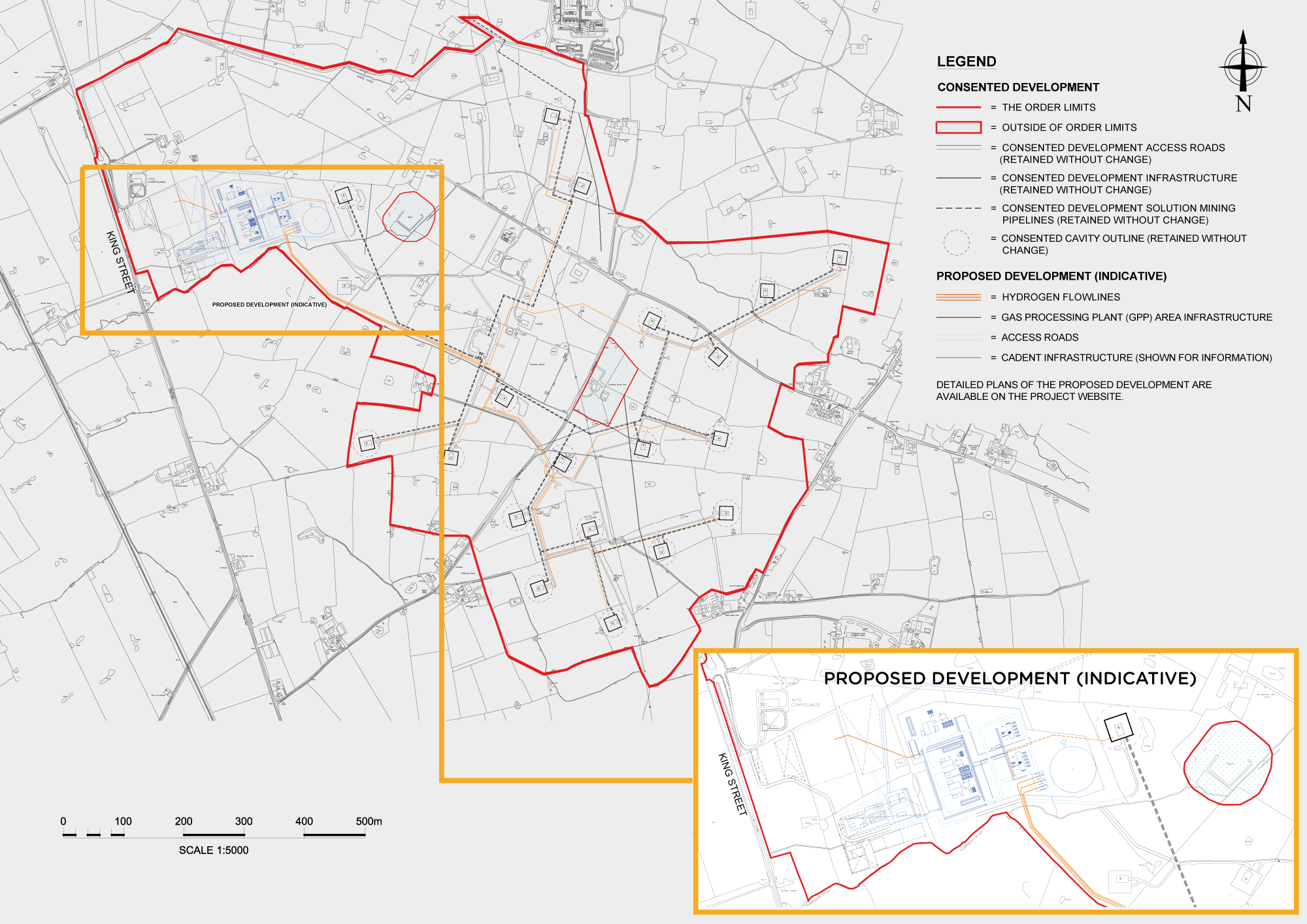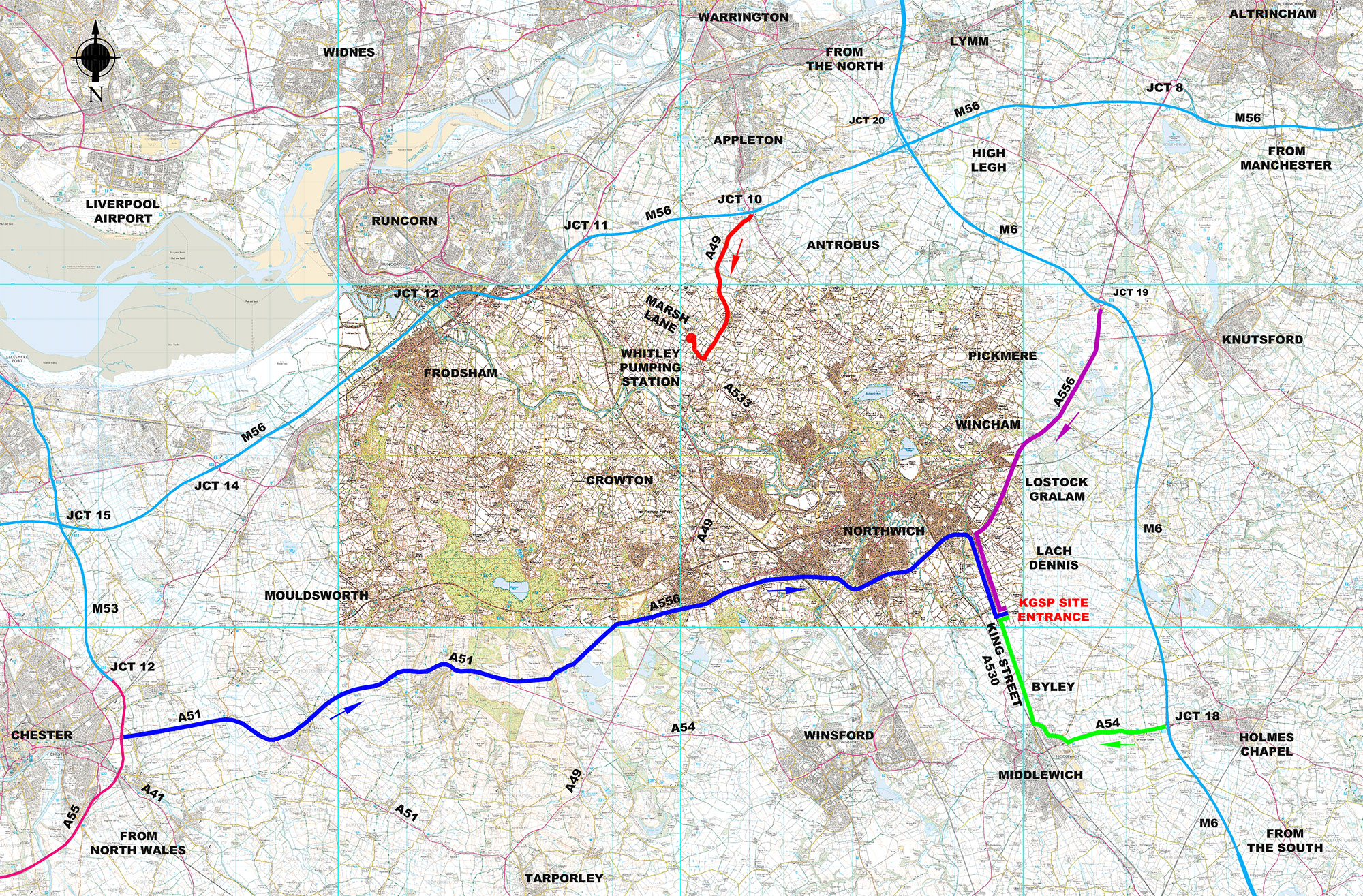The Plans
The KGSP would involve using specially designed underground salt cavities – created through solution mining – to store hydrogen.
Cheshire’s geology means it is one of the few places in the UK where hydrogen can be safely stored underground and INOVYN Enterprises has been solution mining the Holford Brinefield to produce brine for over 90 years. The cavities left behind once the brine is mined have been used to safely store gas since the 1980s.
We are proposing a ‘Material Change’ to the KGSP plans approved in March 2017, to allow the project to store hydrogen rather than natural gas, improve the associated infrastructure and allow connection to the HyNet Hydrogen Pipeline, the regional hydrogen and carbon capture project planned to produce, store and transport hydrogen around the North West and North Wales.
The proposed changes comprise:
- the proposed storage of hydrogen gas rather than natural gas, including consolidation of pipelines;
- changes to the Gas Processing Plant (GPP) area and hydrogen compatible equipment, including a 50m flare instead of a vent;
- moving non-hydrogen equipment to a utility compound adjacent to the GPP;
- the National Transmission System (NTS) for natural gas is being replaced by the Hydrogen Above Ground Infrastructure (HAGI) for connection to the HyNet Hydrogen Pipeline.
If the changes are approved, KGSP will store 1,300 gigawatt hours of hydrogen – more clean energy than any other facility.
Updated Environmental Information
The original consented DCO application was accompanied by an Environmental Statement. The scope of this was agreed with consultees, considered in the examination of the DCO and led to various mitigation measures being identified within the DCO. Those measures will remain in place. The Material Change application will only examine new or changed effects associated with the changes to the scheme now being brought forward. KGSP is engaging with industry experts to provide targeted ecology and environmental surveys in the local area. Topics for consideration in the Preliminary Environmental Information Report (PEIR) and Environmental Statement (ES) are summarised in the table below. These topics have been considered with consultees and technical specialists when assessing the Environmental Impacts of the Material Change Application.
Click here to download copies of the Preliminary Environmental Impact Report Chapters covering the topics below.
| Environmental Topic | Is this topic considered in the environmental statement? | New survey completed? | Why is the topic included in the Material Change? What are the key conclusions? |
|---|---|---|---|
| Geology + Ground Conditions | ✔ | ✔ | Included due to changes sought for the Proposed Development and comments from Non-Material Change (NMC) decision. Effects deemed “Not Significant” in EIA terms for all project phases. |
| Hydrology and Flood Risk | ✔ | ✔ | Included due to updated guidance and changes sought for the Proposed Development. Effects all deemed “Not Significant” in EIA terms for all project phases. |
| Air Quality | ✔ | ✖ | Included due to updated guidance and changes sought for the Proposed Development (flares). Emissions from flaring during operation considered “Not Significant” in EIA terms following assessment and modelling. |
| Noise + Vibration | ✔ | ✔ | Included due to updated guidance, comments from the NMC decision and changes sought for the Proposed Development. Construction Noise effects deemed “Not Significant”. However, Operational Noise effects will be Major / Moderate (Significant) without mitigation, however, will be Minor (Not Significant) with mitigation. |
| Ecology + Nature Conversation | ✔ | ✔ | Included due to updated guidance, comments from the NMC decision and changes sought for the Proposed Development. Effects on all the ecology receptors above deemed “Not Significant” with mitigation in EIA terms across all phases. |
| Landscape + Visual Impact | ✔ | ✔ | Included due to changes sought for the Proposed Development. 12 landscape receptors identified, all have been assessed as Not Significant for construction and operation with the exception of the Site itself. Significant landscape effects (moderate adverse) have been identified on the Site, localised to the north-west corner. |
| Cultural Heritage | ✔ | ✔ | Included due to updated policy and changes sought for the Proposed Development. Heritage assets identified in the PEIR are expected to experience adverse effects ranging from Minor (Not Significant) to Negligible (Not Significant) during all project phases. |
| Socioeconomics | ✔ | ✖ | Included due to updated guidance. Effects on employment, GVA and wider socio economic aspects anticipated to be Not Significant across all project phases. |
| Population and Human Health | ✔ | ✖ | Included due to updated guidance (new EIA chapter) requiring assessment of Proposed Development. Effects on the Social, Biophysical and Economic environment deemed “Not Significant” and effects on health also “Not Significant”. |
| Major Accidents and Disasters | ✔ | ✖ | Included due to updated guidance (new EIA chapter) requiring assessment of Proposed Development, and comments from the NMC decision. The assessment concluded with mitigation construction and operation hazards can be assessed as ‘Not Significant’ in EIA terms. |
| Waste | ✔ | ✖ | Included due to updated guidance (new EIA chapter) requiring assessment of Proposed Development. With mitigation, it is anticipated that waste effects will be Not Significant during both construction and operation. |
| Climate Change and GHG | ✔ | ✖ | There was no standalone chapter for the Consented Development for Climate Change, further information on climate and GHG effects and inclusion of carbon calculations to model emissions associated with the Hydrogen Above Ground Infrastructure. A full-scale Climate and GHG assessment will be included in the Environmental Statement. |
Traffic and Transport
KGSL carefully considered traffic and transport associated with the consented development. Experience of construction of other gas storage projects in the area and feedback from the consultation was taken into account when developing the proposal, in particular the road layout and traffic routing. Drawing on this feedback, it is proposed to use the existing access point on King Street to access the development area, meaning HGVs will not travel through Byley village. An internal, one-way construction routing system is proposed for the main development site. Although the impact is considered negligible based on the existing traffic levels, a Construction Traffic Management Plan will be produced to support the construction phases to ensure that vehicles adhere to the proposed routes. The HGV routing drawing which shows offsite routes to the main entrance is appended to the Section 106 Agreement (a legal obligation) and shown in the Plan below. There are no plans to change the current Agreement as part of the Material Change.
Managing Construction Impacts
Measures will be put in place during construction to minimise disruption to local people. A Construction Environmental Management Plan (CEMP) and Construction Traffic Management Plan (CTMP) will be agreed with Cheshire West & Chester Council in advance of construction starting. This will set out agreed working hours and how potential issues such as noise, lighting and dust will be managed.
Construction hours would be between 0700hrs and 1900hrs Monday to Friday, 0700hrs to 1300hrs on Saturdays, and no working on Sundays or bank holidays. There may be times when construction is 24hrs as some construction activities are required to be continuous, such as cavern creation. However as assessed within the Noise chapter of the PEIR, construction noise from drilling with mitigation would be negligible at all receptors, which would be Not Significant.
Safety
The construction of a GPP and solution mining process of producing underground cavities is almost exactly the same whether it be for hydrogen or natural gas. KGSL will utilise the previous experience and expertise from the neighbouring Storengy Stublach facility to construct the project safely.
The construction and operation of a gas storage facility is heavily regulated by the Health and Safety Executive whose primary function is to ensure workplaces are safe for workers and the public as well as Cheshire West and Chester Council. Hydrogen is already safely stored in salt caverns in Teesside in the UK.
Once operational, the hydrogen storage facility would be staffed 24 hours a day and controlled using modern computer control systems. Operation of the proposed facility would be regulated under the Control of Major Accident Hazards (COMAH) Regulations by the Health & Safety Executive, which requires regular monitoring and review.






